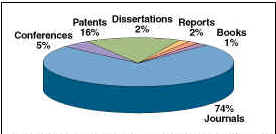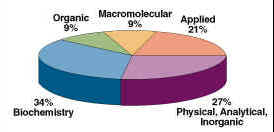

Chemical Abstracts - Part 1

Chemical Abstracts consists of Chemistry Related Literature and Patents
Chemical Abstracts is the
world's largest and most up-to-date collection of chemical information, with
over 18 million abstracts of journal articles, patents and more. Chemical
Abstracts is published by
CAS (Chemical Abstracts Service).

Content by Document Source
Sources for Chemical Abstracts include more than 8,000 journals, patents, technical reports, books, conference proceedings, and dissertations from around the world. About 14,000 records are added every week, with much of the information added to the database on a daily basis.
Chemical Abstracts' References are Growing
The number of documents abstracted and indexed in Chemical Abstracts has been increasing dramatically, reflecting an overall worldwide increase in published scientific research and increased patent activity. Chemical Abstracts is an exceptional patent resource, covering 30 national patent offices and two international bodies. About 16% of the Chemical Abstracts literature, approximately 2.5 million records, are from the patents.

Subject Coverage
Chemical Abstracts has the most Comprehensive Coverage of Chemistry
Chemical Abstracts provides comprehensive coverage of the world's chemical literature, and includes biochemistry, organic chemistry, macromolecular chemistry, applied chemistry and chemical engineering, physical, inorganic and analytical chemistry.
|
|
Chemical Abstracts Consists of Six Indexes
| General Subject Index | This semiannual index covers subject concepts that do not refer to specific chemical substances in the corresponding Chemical Abstracts. These entries include concepts, general classes of chemical substances, applications, uses, properties, reactions, apparatus, processes, and biochemical and biological subjects. |
| Example: | immobilizing proteins on surfaces of yeast cells 165708z (abstract no.) |
| Author Index | Authors, patentees, and patent assignees are listed in alphabetical order in this semiannual index with titles of their articles or patent specifications and abstract numbers. |
| Example: | Bubner, N. A mathematical model for deformation-driven experiments on shape memory alloys, 296185d (abstract number) |
| Chemical Substance Index | This semiannual index relates the Chemical Abstracts index names of chemical substances and their CAS Registry Numbers to Chemical Abstract abstract numbers for documents in which the substances are mentioned. Included with the Chemical Abstract name is a brief description of the document's context. |
| Example: | Phosphatase, glucose 6-[9001-39-2] in decreased cerebral glucose utilization in ebb phase of thermal injury, 111823q (abstract number) |
| Formula Index | This semiannual index relates the molecular formulas for chemical substances with the Chemical Abstracts chemical substance index names, CAS Registry Numbers, and corresponding abstract numbers. |
| Example: | C6 H12 02 Acetic acid 1,1-dimethylethyl ester [540-88-5] 16075a |
| Patent Index | Entries are ordered alphabetically by a two-character code for the country of issue. Under each country the patent documents are listed in numerical order. This semiannual index includes (1) entries for all newly abstracted documents, (2) cross-references to the first-abstracted patent and (3) a listing at the first-abstracted patent of all the equivalent patents. |
| Example: | JP01/006065 A2 - Japanese Patent number - JP (Japan) |
| Index of Ring Systems | This index has been discontinued ; the last such index appears in Volume 121, July-December 1994. Ring composition, ring size, and number of rings are listed providing a means for determining the systematic Chemical Abstract index names for specific ring systems as well as the nonsystematic Chemical Abstract index names for cyclic natural products containing these ring systems. The Index of Ring Systems is found at the end of the Formula Index. |
| Example: | C4S-C5-C6-C6 2H-Cyclopenta [1,2-b] thiophene |
***Please continue onto Chemical Abstracts Part 2***